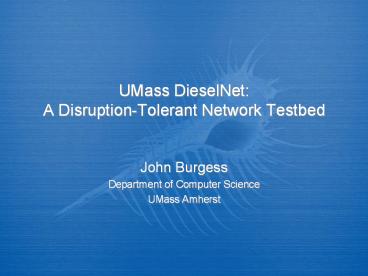UMass DieselNet: A Disruption-Tolerant Network Testbed - PowerPoint PPT Presentation
Title:
UMass DieselNet: A Disruption-Tolerant Network Testbed
Description:
Install new software. Check for new gzip files on prisms web site ... Java implementation with no external dependencies. DTN2 2004 bundle format compatibility ... – PowerPoint PPT presentation
Number of Views:213
Avg rating:3.0/5.0
Title: UMass DieselNet: A Disruption-Tolerant Network Testbed
1
UMass DieselNetA Disruption-Tolerant Network
Testbed
- John Burgess
- Department of Computer Science
- UMass Amherst
2
DieselNet
Vehicular DTN deployed in Amherst and surrounding
county Now includes 40 buses Each bus Linux
brick computer USB 802.11b adapter 802.11b
AP GPS receiver, 40GB hard drive Buses transfer
data as they pass by each other and via available
hot spots.
3
The Openbrick
- Small form factor
- Plentiful I/O
- Binary availability for x86
- 60w peak power draw
- Low heat dissipation
4
DieselNet Software Considerations
- Autonomous operation and shutdown
- Maximal failure tolerance
- No remote administrator login or local terminal
- Physical inaccessibility during operation (6am -
1am) - Nodes versus support staff
- Handle network interface configurations
- Support IP programs
- Handle bundle routing
- Support DTN programs
5
Init and Restore
- Linux and initial software stored on 1st
partition - All DTN software, logs, bundles, cached web
content, etc. stored on 2nd partition - Restore checks for the presence of critical files
- If any critical files are inaccessible
- Clear extended partition
- Restore initial software package from system disk
- Otherwise, Init starts system software
1GB hdc1
39GB hdc5
6
Autoupdate
- Install new software
- Check for new gzip files on prisms web site
- Verify prisms signature
- Install update atomically
- Sync system clock with server
- Report current location
- Report log entries
- Connection events
- Program error messages
- Upload files
- Bzip file, MIME encode it, and upload via HTTP
request header
7
LiveIP
- Manage network interfaces
- 802.11b
- Scan for ssid broadcasts on all channels
- Connect to other buses
- Hash foreign bus MAC address to determine subnet
- Connect to access points
- DHCP
- Ping foreign device to decide when to resume
scanning - Reload 802.11 driver to clear malfunctions
- Additional interfaces to be managed
- 900mhz long-range radio (1km)
- CDMA modem
8
GPSupdate
- Receive NMEA formatted information via RS232
- Compute speed, direction, etc.
- Periodically log location
- Provide location information to onboard programs
9
DTNdaemon
- Accept data and send bundles
- via local TCP socket
- Route bundles according to configured protocol
- MaxProp
- Deliver data to appropriate onboard programs
- Programs connect via TCP socket
- Programs register as appropriate destination
application - Platform and IP network interface independent
- Java implementation with no external dependencies
- DTN2 2004 bundle format compatibility
10
Software Components
- Init and Restore
- Perl and Python
- Auto update
- Python
- Live IP
- Java 1.4
- GPS update
- Python
- DTN daemon
- Java 1.4 and linux-only Java 1.3
11
Connection Events
- Red dots indicate bus-to-bus transfers
- (1 month)
- Measurement of real TCP throughput
- Traces collected everyday
12
Measurements
Buses log their status via available access
points (and update software).
Transfer duration
Inter-transfer opportunity time
Bytes transferred
13
Future Work
- Deploy different DTN routing protocols
- Develop useful disruption tolerant applications
- Expand network to include other types of nodes
14
Summary
- DieselNet is a DTN Testbed deployed on public
transportation busses - Network inaccessibility often corresponds to
physical inaccessibility, making DTN
administration difficult - DTN system administration must be accomplished in
a disruption-tolerant manner - Current above-IP DTN solutions must handle
configuration of IP, Link, and physical network - Future solutions running above the link layer
will still need to configure the link and
physical layer































